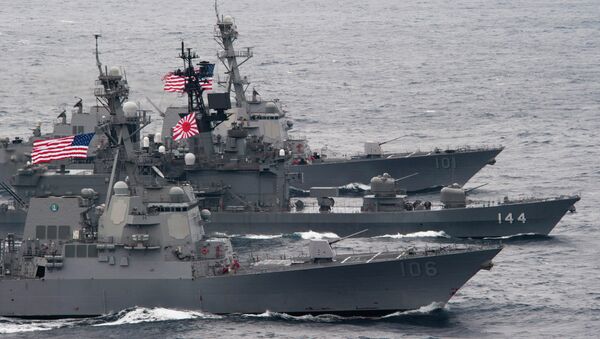Earlier this month, reports surfaced which detailed the 2016 budget for the Japanese Ministry of Defense. Reaching a new record in military spending for a nation that has upheld a pacifist constitution for the last 70 years, the MOD has requested 5 trillion yen ($40.3 billion).
Part of that money will go toward the purchase of new airborne refueling aircraft, but the bulk will be spent on construction of a new class of naval destroyed, equipped with the latest missile defense system.
Details about those ships, tentatively called the 27DDG class, have been kept relatively secret. But a notification from the US Defense Security Cooperation Agency (DSCA) describes a possible $1.5 billion sale of two Aegis combat systems to the Japanese military.
The AEGIS Weapon System MK 7 includes the SPY-1D radar, developed by Lockheed Martin. The deal would also include underwater surveillance and communication systems, a Multi-Function Tower Array, a MK 41 Vertical Launch System, and a SM-3 ballistic missile defense system.
The new ships may also feature advanced weapons systems not provided by the United States. Blueprints released by the MOD hinted at the possibility of laser-based air defense technology and electromagnetic railguns.
The Liberal Democratic Party of Prime Minister Shinzo Abe has been pushing to repeal Article 9 of the Japanese constitution, in place since the end of World War II. That article states that "the Japanese people forever renounce war as a sovereign right of the nation."
To achieve that repeal, Abe has fought for legislation which would permit the stationing of Japanese military troops abroad. The prime minister also lifted a ban on the export of defense equipment.
While the Japanese government has always maintained a Self-Defense Force consisting of a large naval fleet, those ships have been primarily used for disaster relief purposes.
Much of the push for militarization has come at the behest of the United States. Fearful of an alleged growing Chinese influence, Washington has pressed Pacific allies into pursuing a more provocative military stance.
In particular, the US is concerned about Beijing’s construction of artificial islands in the South China Sea. A highly contested region through which nearly $5 trillion in trade passes annually, the US is worried that the Chinese government could use the islands to establish an air defense zone.
Beijing has repeatedly expressed that it has every right to construct within its own territory, and that the islands will be primarily used for humanitarian purposes.
Japan is also involved in territorial disputes with China in the East China Sea, where oil and natural gas stockpiles are leading to conflict.
"China and Japan have not yet delineated maritime boundaries in the East China Sea, and China does not recognize the Japanese side’s unilateral marking out of a so-called ‘median line,'" China’s Foreign Ministry said in a statement.





